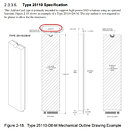TheLostSwede
News Editor
- Joined
- Nov 11, 2004
- Messages
- 18,933 (2.51/day)
- Location
- Sweden
| System Name | Overlord Mk MLI |
|---|---|
| Processor | AMD Ryzen 7 7800X3D |
| Motherboard | Gigabyte X670E Aorus Master |
| Cooling | Noctua NH-D15 SE with offsets |
| Memory | 32GB Team T-Create Expert DDR5 6000 MHz @ CL30-34-34-68 |
| Video Card(s) | Gainward GeForce RTX 4080 Phantom GS |
| Storage | 1TB Solidigm P44 Pro, 2 TB Corsair MP600 Pro, 2TB Kingston KC3000 |
| Display(s) | Acer XV272K LVbmiipruzx 4K@160Hz |
| Case | Fractal Design Torrent Compact |
| Audio Device(s) | Corsair Virtuoso SE |
| Power Supply | be quiet! Pure Power 12 M 850 W |
| Mouse | Logitech G502 Lightspeed |
| Keyboard | Corsair K70 Max |
| Software | Windows 10 Pro |
| Benchmark Scores | https://valid.x86.fr/yfsd9w |
NVMe SSDs based on the M.2 form factor come in several different lengths today, ranging from 30 to 110 mm, although the 30 mm drives are rare and the 110 mm drives have so far been reserved for the server space. However, they've all had one thing in common, the 22 mm width, as otherwise there might be issues in terms of fitting the drives, especially in notebooks. However, it appears that the PCI-SIG snuck in a wider, 25 mm option for M.2 SDDs at the end of 2020, but seemingly forgot to mention it to anyone. The only reason we even noticed, was because Gigabyte listed its upcoming X670 and X670E motherboards as having support for 25110 SSD's, where you'd expect to see support for 2280 or 22110 drives.
An extra 3 mm in width might not sound like much, but many M.2 drives seem to be somewhat space constrained, mainly with regards to the passive components and the power regulation. It also seems like this is in preparation for PCIe 5.0 NVMe drives, where the host controller is expected to run hotter, even though it might not be as bad as initially expected. Regardless, it seems like motherboard makers are now making space for this slightly wider M.2 form factor, as well as implementing suitable cooling solutions to match. Whether we'll see drives using this slightly wider form factor or not, is still up in the air and one reason why the SSD manufacturers might choose not to go wider, is because new drives might not fit in older motherboards and laptops, if the clearance is too small.


View at TechPowerUp Main Site | Source
An extra 3 mm in width might not sound like much, but many M.2 drives seem to be somewhat space constrained, mainly with regards to the passive components and the power regulation. It also seems like this is in preparation for PCIe 5.0 NVMe drives, where the host controller is expected to run hotter, even though it might not be as bad as initially expected. Regardless, it seems like motherboard makers are now making space for this slightly wider M.2 form factor, as well as implementing suitable cooling solutions to match. Whether we'll see drives using this slightly wider form factor or not, is still up in the air and one reason why the SSD manufacturers might choose not to go wider, is because new drives might not fit in older motherboards and laptops, if the clearance is too small.


View at TechPowerUp Main Site | Source



